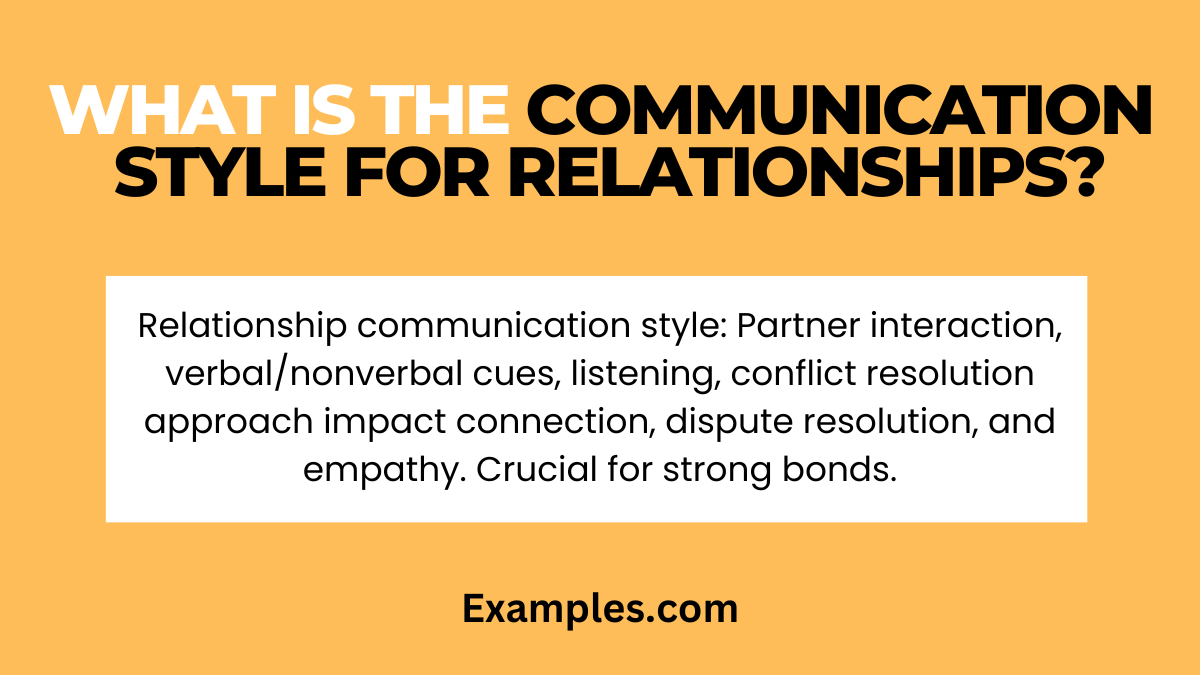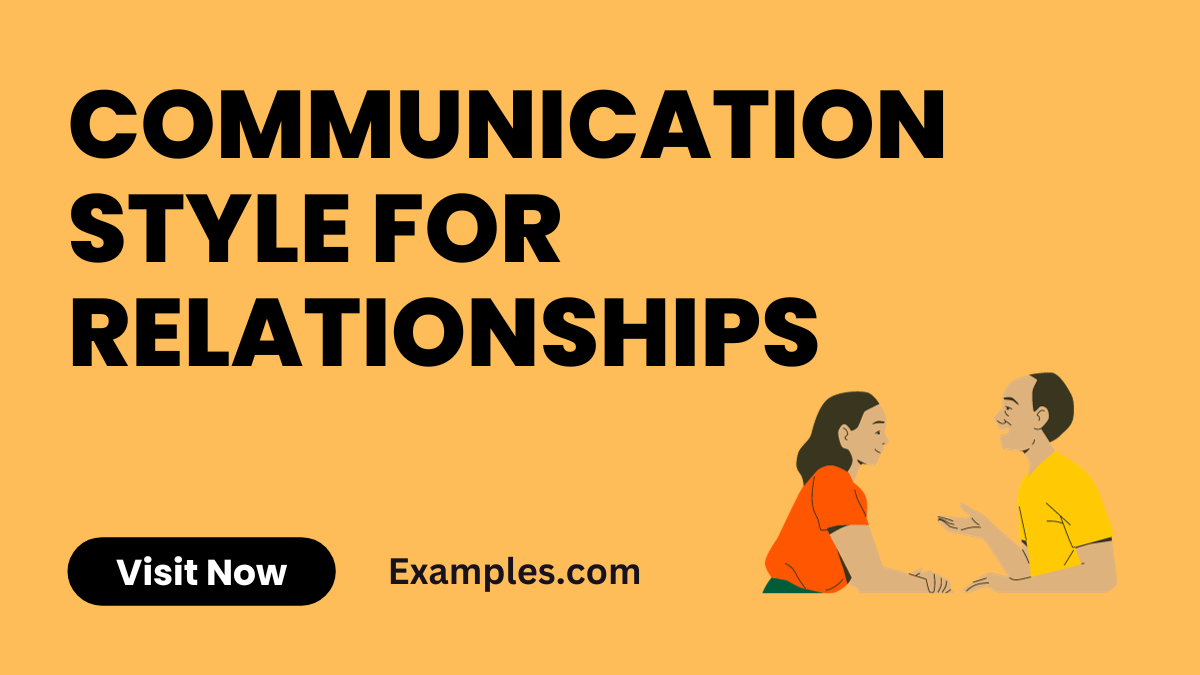19+ Communication Style for Relationships Examples
Dive into the intricate world of Communication Style for Relationships with this comprehensive guide. Unravel the nuances of relationship dynamics through various Communication Examples. Discover how different styles influence connection and understanding, and explore practical examples to enhance your relational communication. This guide offers key insights into fostering healthier, more fulfilling relationships through tailored communication techniques.
What is the Communication Style for Relationships? – Meaning

Communication style in relationships refers to the way individuals express themselves and interact with their partners. It encompasses verbal and non-verbal cues, listening skills, and the approach to conflict resolution. This style significantly impacts the health and dynamics of a relationship, influencing how partners connect, resolve disputes, and support each other. Understanding one’s communication style and that of their partner is crucial for building a strong, resilient, and empathetic bond.
What is the Best Example of Communication Style for Relationships?

The best example of a communication style for relationships is often seen in Assertive Communication Style. This style is characterized by honesty, clarity, respect, and empathy. Assertive communicators express their needs and feelings confidently yet respectfully, listen actively, and seek mutual understanding. They balance their own needs with those of their partner, fostering an environment of trust and openness. This style helps in preventing misunderstandings, resolving conflicts amicably, and deepening the emotional connection between partners.
20 Communication Style for Relationships Examples

Discover the impact of various communication style for relationships examples. This list delves into 20 distinct styles, identifying their causes and suggesting improvements. Each style, from assertive to critical, plays a unique role in relationship dynamics, and understanding them is key to nurturing healthier connections.
- Assertive: Open, honest.
Cause: Confidence. Fix: Foster openness. - Passive: Avoids conflict.
Cause: Fear. Fix: Build confidence. - Aggressive: Dominates.
Cause: Control. Fix: Practice empathy. - Passive-Aggressive: Indirect.
Cause: Avoidance. Fix: Be direct. - Non-Verbal: Body language.
Cause: Discomfort. Fix: Verbalize feelings. - Active Listening: Empathetic.
Cause: Emotional intelligence. Fix: Encourage mutual listening. - Reflective: Mirroring.
Cause: Harmony. Fix: Balance communication. - Open Communication: Freely sharing.
Cause: Trust. Fix: Maintain openness. - Conflict-Avoidant: Avoids disagreements.
Cause: Fear. Fix: Learn resolution. - Direct: Straightforward.
Cause: Honesty. Fix: Add empathy. - Indirect: Hinting.
Cause: Fear. Fix: Be more direct. - Empathetic: Emotionally attuned.
Cause: Sensitivity. Fix: Foster empathy. - Closed: Reserved.
Cause: Distrust. Fix: Build trust. - Manipulative: Controlling.
Cause: Control. Fix: Promote honesty. - Casual: Informal.
Cause: Comfort. Fix: Address serious issues. - Sarcastic: Ironic.
Cause: Defense. Fix: Communicate clearly. - Emotional: Feelings-led.
Cause: Sensitivity. Fix: Balance emotion and logic. - Rational: Logic-focused.
Cause: Practicality. Fix: Understand emotions. - Supportive: Encouraging.
Cause: Uplifting. Fix: Balance with honesty. - Critical: Fault-finding.
Cause: Expectations. Fix: Be positive.
Communication Style for Workplace Relationships
In a professional setting, cultivating effective communication styles for relationships is vital. This guide explores five essential strategies tailored to foster workplace relationships within the context of communication styles in the workplace with communication styles in Leadership. Here are five key strategies:
- Active Listening: Show genuine interest in colleagues’ concerns. “I appreciate your input; let’s explore your ideas further.”
- Collaboration: Encourage teamwork in decision-making.”Let’s work together to enhance our processes.”
- Leadership Communication: Inspire and guide with open dialogue. “As a leader, I value open communication.”
- Conflict Resolution: Navigate conflicts with empathy and solutions. “Let’s address this issue constructively.”
- Adaptability: Adjust your style for diverse colleagues. “I’ll tailor my approach to suit your preferences.”
Assertive-Passive Communication Style for Relationships
Balancing assertiveness and passivity is crucial in nurturing healthy relationships. Explore this guide on applying assertive-passive communication styles, tailored for project managers and interview settings. In the role of a Communication Style for Project Managers, this approach helps in being assertive about project goals and passively encouraging team input. In an Interview Communication Style, utilize assertive-passive communication to confidently assess candidates while allowing them to express themselves. For example, ask, “Tell me about your strengths, and feel free to ask questions.”
- Clear Expectations: Express your needs or expectations assertively while respecting the other person’s viewpoint.
- Active Listening: Engage wholeheartedly in the conversation and acknowledge the speaker’s emotions.
- Open Dialogue: Foster open communication, creating a safe space for both parties to voice their thoughts.
- Respect Boundaries: Understand personal boundaries and maintain them during discussions.
- Constructive Feedback: Provide feedback assertively, emphasizing solutions over blame.
Download Communication Style for Couples in Relationships PDF
Communication Style for Relationships Psychology
In the realm of Relationships Psychology, understanding and adapting communication styles is key to fostering healthy and fulfilling relationships. Utilizing Communication Style Worksheets and Communication Style Assessment can aid in this process. Here are five examples of communication styles pivotal in relationships:
- Active Listening: Focus fully on the partner, showing empathy. “I hear what you’re saying, and it makes sense to me.”
- Open and Honest: Share thoughts and feelings transparently. “I feel concerned when plans change suddenly without discussion.”
- Non-Verbal Cues: Use body language to show engagement. “My open posture and eye contact show I’m listening.”
- Constructive Feedback: Offer feedback in a supportive manner. “I appreciate your efforts, and I wonder if we could try this differently.”
- Conflict Resolution: Address issues calmly and patiently. “Let’s find a common ground to resolve this disagreement.”
Why Communication Styles Affect Relationships and How to Fix It?
Communication styles deeply impact relationship dynamics. Misunderstandings and conflicts often stem from mismatched styles. To improve communication:
- Recognize Your Style: Identify if you use Assertive, Passive, or other styles.
- Understand Your Partner’s Style: Acknowledge their communication approach, whether it’s Open or Passive-Aggressive.
- Adapt and Compromise: Adjust your style for better compatibility.
- Use Assertive Communication: Encourage honest and direct dialogue.
- Seek Common Ground: Find areas of agreement to build understanding.
Navigating Communication Style for Relationships
Navigating different communication styles in relationships is crucial for building a healthy, understanding, and supportive environment. Effective communication fosters connection and resolves conflicts, making it essential in any relationship. Improving relationships through communication skills, emphasizing the need for understanding and adapting personal communication styles to enhance relationship dynamics University Health Services, Berkeley. A complete guide on the power of effective communication in building strong relationships. It highlights the importance of emotional connections and understanding different communication styles for a deeper bond LoveDiscovery.
Why are Communication Styles in Relationships Important?
Effective communication is the cornerstone of healthy relationships. Understanding and adapting to different styles enhances connection and reduces conflicts.
- Promote Understanding: Recognize the Types of Communication Styles to better understand each other.
- Avoid Misinterpretations: Differentiate between Aggressive Communication Styles to prevent misunderstandings.
- Enhance Connection: Utilize Open Communication Style to deepen the bond.
- Reduce Conflict: Recognize and address Passive or Manipulative Communication Styles.
- Build Trust: Honest and clear communication fosters trust and respect.
What Are the Types of Communication Styles?
The four types of communication styles are Assertive, Passive, Aggressive, and Passive-Aggressive. Each significantly impacts relationship dynamics.
What Are the main Communication Styles?
The five communication styles include Assertive, Passive, Aggressive, Passive-Aggressive, and Reflective Communication Style. Each plays a unique role in interpersonal relationships.
Which Communication Style Will Enhance Your Relationships?
The Assertive Communication Style typically enhances relationships. It’s clear and respectful, allowing for healthy dialogue. A Reflective Communication Style can also be beneficial for understanding and empathy.
In conclusion, understanding communication styles in relationships is crucial. Recognizing and adapting to styles like Assertive, Passive, Aggressive, and Reflective can profoundly impact relationship health. Effective communication fosters mutual understanding, reduces conflicts, and strengthens bonds. By identifying and addressing communication challenges, couples can enhance their connection and navigate through misunderstandings more effectively.



